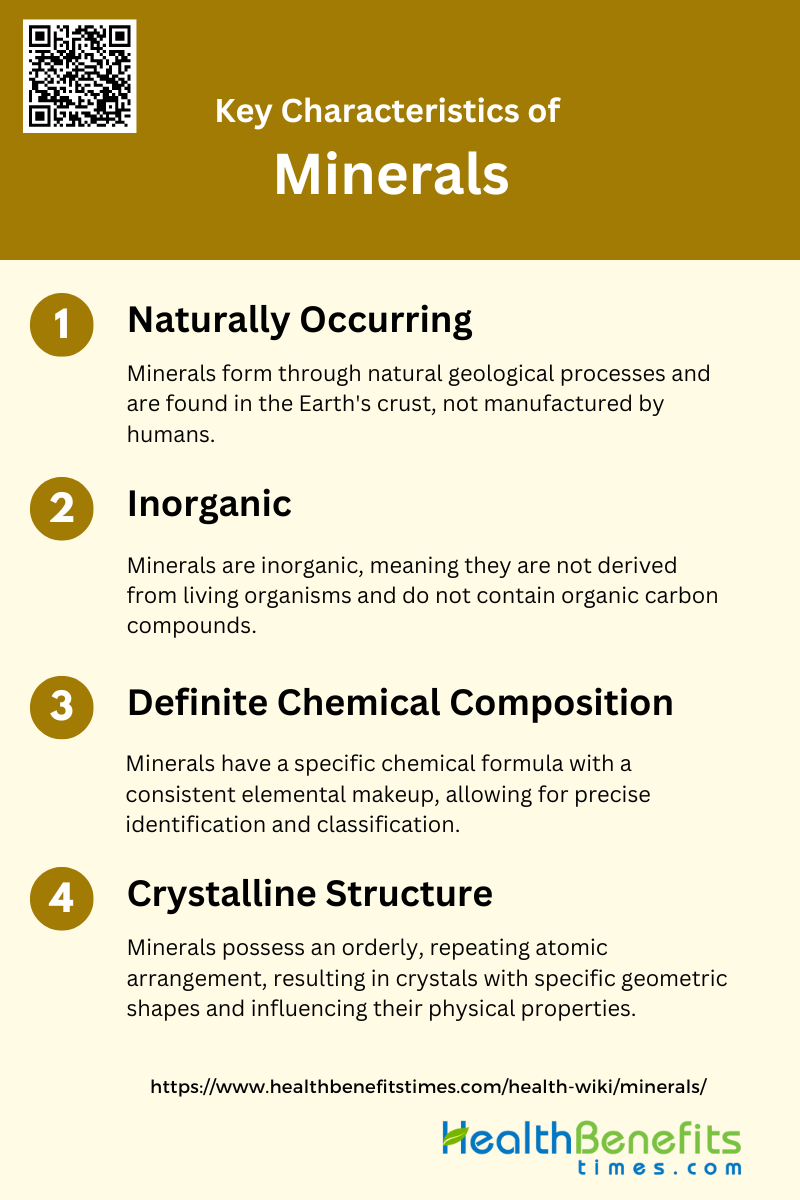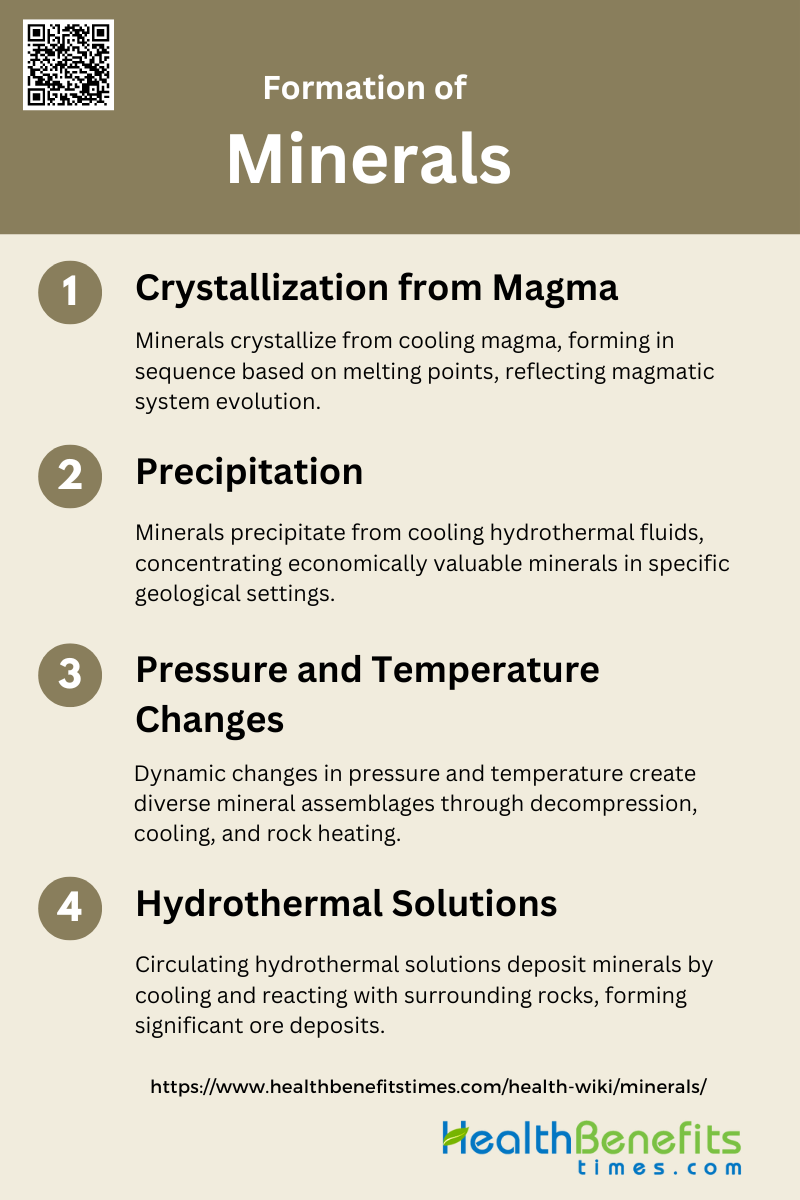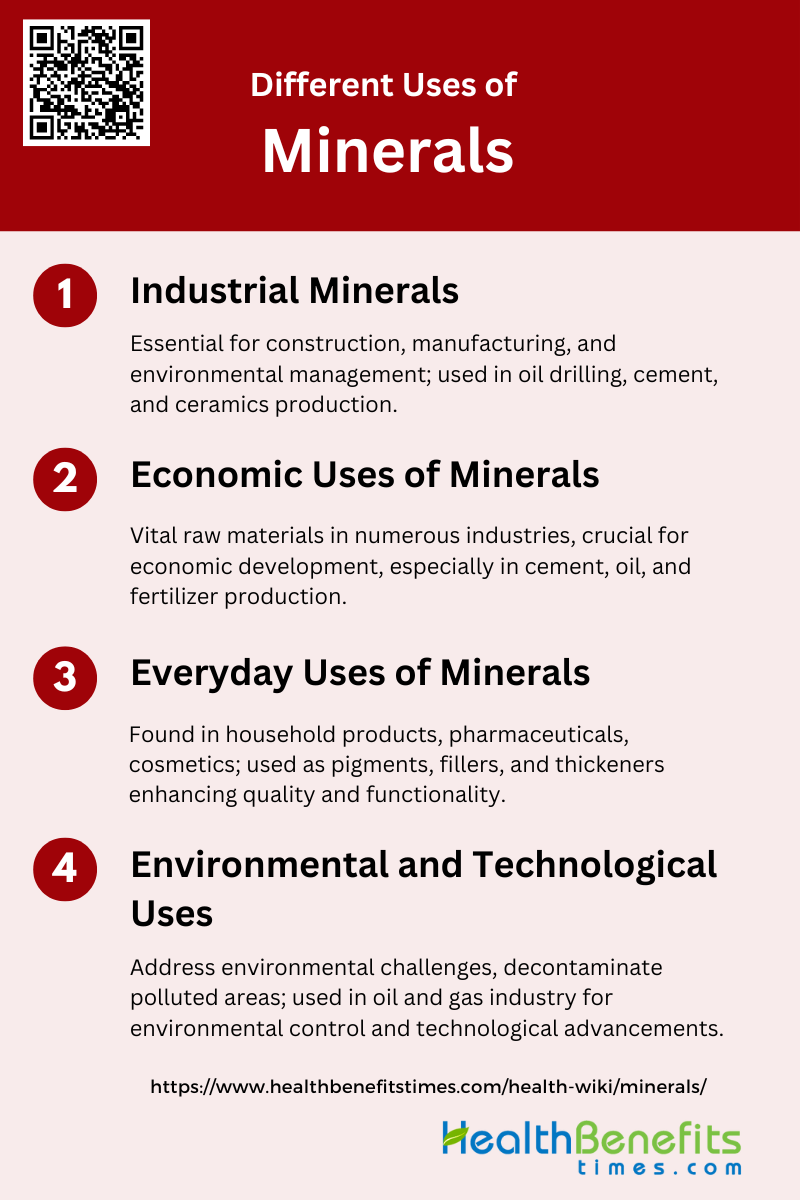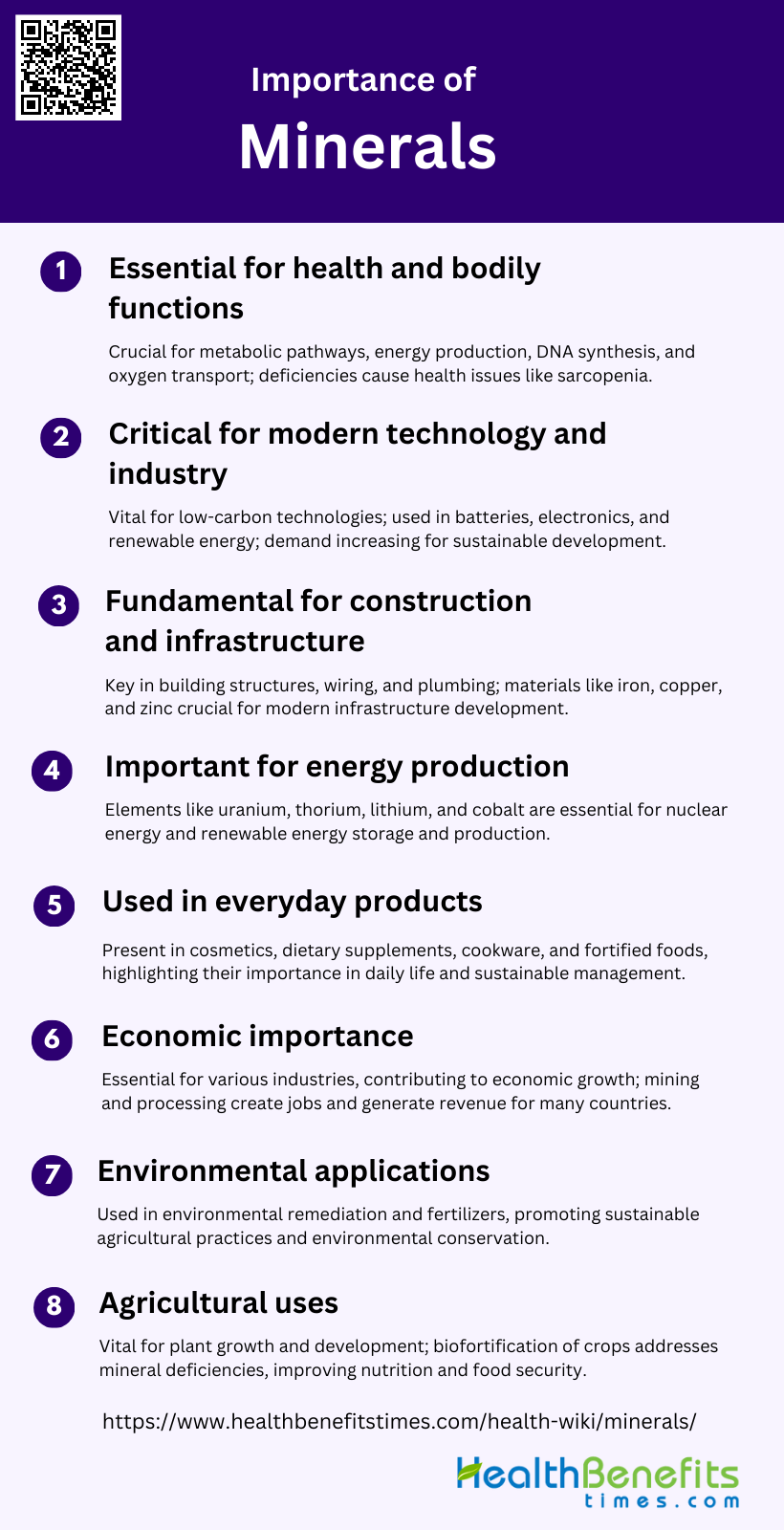Minerals are naturally occurring, inorganic solid substances with a definite chemical composition and an ordered internal crystal structure. They are the building blocks of rocks and are essential components of the Earth’s crust. Minerals can form through various geological processes, including crystallization from magma, precipitation from water, or metamorphism of existing rocks. They are characterized by specific physical properties such as hardness, luster, color, streak, cleavage, and crystal form, which can be used to identify them. Minerals play crucial roles in many aspects of our lives – they are mined for industrial and technological applications, used as gemstones, and some are essential nutrients for living organisms. Common examples of minerals include quartz, feldspar, mica, calcite, and halite (rock salt). While thousands of mineral species have been identified, only about 100 are considered common rock-forming minerals.
Key Characteristics of Minerals
These characteristics ensure that minerals are consistent in their composition and structure, making them identifiable and classifiable. The key characteristics of minerals include:
1. Naturally Occurring
They are found in the Earth’s crust and are not manufactured by humans. This natural formation process is crucial for a substance to be classified as a mineral. For example, diamonds formed deep within the Earth under high-pressure conditions are considered minerals, whereas synthetic diamonds created in labs are not. This characteristic ensures that minerals are products of the Earth’s natural processes, contributing to their unique properties and occurrences in nature.
2. Inorganic
This distinguishes them from organic substances, which are typically associated with life forms and contain carbon-hydrogen bonds. Inorganic minerals are composed of elements or compounds that have never been alive. For instance, quartz (SiO₂) and feldspar are inorganic minerals, whereas substances like coal, which originates from decomposed plant material, are not considered minerals despite their natural occurrence.
3. Definite Chemical Composition
A defining feature of minerals is their definite chemical composition, which means that each mineral has a specific chemical formula that describes its elemental makeup. This composition can vary slightly due to the presence of impurities, but the fundamental chemical structure remains consistent. For example, the mineral halite has a chemical formula of NaCl, indicating it is composed of sodium and chlorine in a 1:1 ratio. This precise chemical makeup allows for the identification and classification of minerals based on their chemical properties.
4. Crystalline Structure
Minerals possess a crystalline structure, meaning their atoms are arranged in an orderly, repeating pattern. This ordered atomic arrangement results in the formation of crystals with specific geometric shapes. The crystalline structure is a critical aspect of a mineral’s identity, influencing its physical properties such as hardness, cleavage, and fracture. For instance, the crystalline structure of diamond, which consists of carbon atoms arranged in a tetrahedral lattice, gives it its renowned hardness. This characteristic differentiates minerals from amorphous substances, which lack a defined atomic arrangement.
Types of Minerals
Minerals are classified based on their chemical composition and internal structure, leading to a diverse range of types. Understanding these classifications helps in identifying and studying minerals more effectively. The main types of minerals include:
1. Classification of Minerals
Traditional systems focus on idealized end-member compositions and structures, but recent approaches suggest incorporating evolutionary aspects, linking mineral species to their paragenetic modes. This evolutionary system considers the formation environments and histories of minerals, providing a richer narrative of planetary evolution. Below is the two types of Classification of minerals:
- Silicate Minerals: Silicate minerals contain silicon and oxygen in their chemical structure and make up over 90% of Earth’s crust. They are classified based on their silicate anion structure into groups like nesosilicates, inosilicates, phyllosilicates, and tectosilicates. Common examples include quartz, feldspar, mica, and olivine.
- Non-Silicate Minerals: Non-silicate minerals do not contain silicon-oxygen tetrahedra in their structure. They are classified into groups based on their dominant anion or anionic group, including native elements, sulfides, oxides, carbonates, phosphates, and halides. Examples include gold, pyrite, hematite, calcite, apatite, and halite.
2. Major Classes of minerals
The major classes of minerals are typically categorized based on their chemical composition and industrial applications. For example, industrial minerals and rocks are grouped according to their patterns of use, which can be physical, chemical, or a combination of both. This classification helps in understanding the diverse applications of minerals in various industries, such as construction, manufacturing, and technology. The tourmaline group minerals, for instance, are divided into alkali, calcic, and X-site-vacant tourmalines, each with specific chemical and structural characteristics that determine their industrial and scientific applications.
- Native Elements: Native elements are minerals composed of a single element. Examples include gold, silver, and copper, which occur in pure form in nature.
- Sulfides: Sulfides are minerals where sulfur is combined with a metal or semimetal. Common examples include pyrite (FeS₂) and galena (PbS).
- Oxides: Oxides are minerals where oxygen is bonded to one or more metal elements. Hematite (Fe₂O₃) and magnetite (Fe₃O₄) are notable examples.
- Halides: Halides are minerals formed from halogen elements like fluorine, chlorine, bromine, and iodine. Examples include halite (NaCl) and fluorite (CaF₂).
- Carbonates: Carbonates are minerals containing the carbonate ion (CO₃²⁻). Calcite (CaCO₃) and dolomite (CaMg(CO₃)₂) are well-known carbonates.
- Sulfates: Sulfates are minerals that include the sulfate ion (SO₄²⁻). Gypsum (CaSO₄·2H₂O) and barite (BaSO₄) are common sulfate minerals.
- Phosphates: Phosphates are minerals containing the phosphate ion (PO₄³⁻). Apatite (Ca₅(PO₄)₃(F,Cl,OH)) is a significant phosphate mineral.
Formation of Minerals
Minerals form through a variety of geological processes that occur both on and beneath the Earth’s surface. These processes result in the crystallization of minerals from molten rock, solutions, or through metamorphic transformations. The primary methods of mineral formation include:
1. Crystallization from Magma
Crystallization from magma is a fundamental process in the formation of minerals. As magma cools, minerals begin to crystallize in a specific sequence based on their melting points. For instance, in the Black Mountain porphyry Cu-Au deposit, early crystallized plagioclase phenocrysts exhibit distinct strontium isotope values, indicating crystallization from a stable felsic magma chamber. The presence of magmatic titanite with specific Nb/Ta, Zr/Hf, and Y/Ho values further reflects the crystallization effects during the magmatic stage. This process is crucial in understanding the mineral composition and the evolution of magmatic systems.
2. Precipitation
Precipitation is another key mechanism in mineral formation, particularly in hydrothermal environments. When mineral-laden hydrothermal fluids cool or undergo chemical changes, minerals precipitate out of the solution. In the Black Mountain deposit, hydrothermal titanite and epidote show a gradual decrease in rare earth elements, Y, Zr, and U contents from early to late stages, indicating the evolution of hydrothermal fluids with decreasing temperature. This process is essential for the formation of mineral deposits, as it leads to the concentration of economically valuable minerals in specific geological settings.
3. Pressure and Temperature Changes
Changes in pressure and temperature significantly influence mineral formation. In magmatic-epithermal environments, repeated magma intrusions can heat surrounding rocks to plastic behavior temperatures (>400°C), creating a self-sealed zone that separates lithostatically pressured regions from hydrostatically pressured ones. Breaches in this zone, often triggered by upward magma surges, allow hypersaline brine and gas to move into cooler, brittle rock, leading to the formation of epithermal veins through decompression and cooling. These dynamic conditions facilitate the formation of diverse mineral assemblages and are critical in the development of mineral deposits.
4. Hydrothermal Solutions
Hydrothermal solutions play a pivotal role in mineral formation, particularly in the context of ore deposits. These solutions, often derived from magmatic fluids, circulate through fractures and porous rocks, depositing minerals as they cool and react with the surrounding rock. In the Black Mountain deposit, the interaction of mafic magma-derived fluids with felsic magma-derived fluids, along with an additional fluid source from wall-rock limestone, resulted in the formation of hydrothermal epidote with highly radiogenic 87Sr/86Sr values. This process underscores the complexity and importance of hydrothermal solutions in mineralization, contributing to the formation of economically significant mineral deposits.
Physical Properties of Minerals
Understanding the physical properties of minerals is essential for their identification and classification. These properties, which can be observed or measured, include characteristics such as color, hardness, luster, and cleavage. Below is a list of the key physical properties used to identify minerals:
1. Color
The color of a mineral is one of its most noticeable physical properties and can vary widely even within a single mineral type. For instance, haywoodite is described as colorless to pale pink, while hanahanite is light blue. The color is influenced by the mineral’s chemical composition and the presence of trace elements or impurities. However, color alone is not always a reliable diagnostic property because it can be affected by surface weathering or exposure to light.
2. Streak
Streak refers to the color of the mineral in its powdered form, which is often more consistent than the color of the mineral itself. Both haywoodite and hanahanite have a white streak, indicating that their powdered form does not vary in color. Streak is a useful diagnostic property because it is less affected by surface conditions and impurities compared to the mineral’s overall color.
3. Luster
Luster describes how a mineral reflects light, which can range from metallic to dull. Haywoodite and hanahanite both exhibit a vitreous luster, meaning they have a glass-like appearance. Luster is an important property for identifying minerals as it provides clues about the mineral’s surface properties and internal structure.
4. Hardness
Hardness measures a mineral’s resistance to scratching and is quantified using the Mohs scale. Haywoodite has a Mohs hardness of 2½, while hanahanite has a hardness of 3. This property is crucial for identifying minerals and understanding their potential uses and durability. Hardness is determined by the mineral’s atomic structure and bonding.
5. Cleavage and Fracture
Cleavage describes how a mineral breaks along specific planes of weakness, while fracture refers to how it breaks when cleavage is not present. Haywoodite has one perfect cleavage on {011} and a curved and stepped fracture, whereas hanahanite has one very good cleavage on {001} and a curved fracture. These properties are essential for identifying minerals and understanding their structural integrity.
6. Density
Density, or specific gravity, is the mass of a mineral per unit volume. Haywoodite has a measured density of 3.27 g/cm³, and hanahanite has a density of 3.28 g/cm³. Density is influenced by the mineral’s composition and atomic structure and is a key property for identification and classification.
Different Uses of Minerals
Minerals play a crucial role in various aspects of human life and industry, providing essential materials for construction, technology, and health. Their diverse applications span from building infrastructure to enhancing electronic devices and supporting agricultural productivity. Below are some of the key uses of minerals:
1. Industrial Minerals
Industrial minerals are essential raw materials for various industries, including construction, manufacturing, and environmental management. These minerals, such as limestone, clay, kaolin, gravel, and sand, are extracted in large quantities to support industrial activities. For instance, in Germany, 600 million tonnes of these materials are extracted annually from quarries, dredging lakes, sand pits, and gravel pits. Additionally, industrial minerals like bentonite and barite are crucial in the oil and gas industry for drilling mud and propping agents. Their unique properties make them indispensable in numerous industrial applications, contributing significantly to economic development.
2. Economic Uses of Minerals
Minerals play a pivotal role in economic development by serving as essential raw materials in various industries. The value of industrial mineral production often surpasses that of metallic minerals, especially in developed countries. These minerals are vital in industries such as cement manufacturing, oil drilling, and ceramics production. For example, phosphate minerals are crucial for producing fertilizers, which are essential for agriculture. The economic significance of these minerals is underscored by their widespread use and the necessity for countries to have reliable sources of these raw materials to support industrial growth and development.
3. Everyday Uses of Minerals
Minerals are integral to everyday life, found in numerous household and personal care products. For instance, clay minerals are used in pharmaceuticals as excipients, providing properties like high adsorption capacity and reactivity to acids, which are essential for drug formulation. Additionally, minerals are used in traditional Chinese medicine and modern therapies to combat viral infections and antimicrobial resistance. In everyday products, minerals serve as pigments, fillers, and thickeners, enhancing the quality and functionality of items ranging from cosmetics to cleaning agents. Their versatility and beneficial properties make minerals indispensable in daily life.
4. Environmental and Technological Uses
Minerals are crucial in addressing environmental challenges and advancing technological applications. Industrial minerals like carbonates, clays, and zeolites are used to mitigate environmental issues by immobilizing contaminants in polluted water and soils. These minerals have significant adsorption capacities, making them effective in decontaminating land affected by mining or waste landfills. Technologically, minerals are used in various applications, such as drilling materials in the oil and gas industry, where they support environmental control measures. Their unique properties enable innovative solutions for environmental management and technological advancements.
Importance of Minerals
Minerals are fundamental to various industries and everyday life, providing essential components for construction, technology, and healthcare. Their unique properties make them indispensable in numerous applications, from building materials to electronic devices and nutritional supplements. Below are some of the key reasons why minerals are important:
1. Essential for health and bodily functions
Minerals are crucial for maintaining health and supporting various bodily functions. They play significant roles in metabolic pathways, including energy production, DNA synthesis, and oxygen transport, which are vital for brain and muscle function. For instance, calcium is essential for bone health and muscle function, while iron is necessary for oxygen transport in red blood cells. Deficiencies in minerals can lead to various health issues, such as sarcopenia, characterized by the loss of muscle mass and strength in older adults. Therefore, adequate mineral intake is essential for overall health and well-being.
2. Critical for modern technology and industry
Minerals are indispensable in modern technology and industry. Critical minerals (CMs) like cobalt, chromium, manganese, nickel, and zinc are vital for the development of low-carbon technologies and innovations. These minerals are used in the production of batteries, electronics, and renewable energy technologies, which are essential for sustainable development. Understanding the health effects of exposure to these minerals is crucial for their responsible handling and harvesting. The demand for these minerals is increasing, making their sustainable use and availability a priority for national and economic security.
3. Fundamental for construction and infrastructure
Minerals are fundamental in the construction and infrastructure sectors. Materials like iron, copper, and zinc are essential for building structures, electrical wiring, and plumbing systems. Calcium, in the form of limestone, is a primary component of cement, which is crucial for construction. Phosphorus is used in the production of steel, which is a key material in infrastructure development. The availability and sustainable use of these minerals are critical for the development and maintenance of modern infrastructure, supporting economic growth and development.
4. Important for energy production
Minerals play a significant role in energy production. Elements like uranium and thorium are used in nuclear energy production, providing a significant source of low-carbon energy. Additionally, minerals like lithium, cobalt, and nickel are essential for the production of batteries used in renewable energy storage and electric vehicles. The efficient and sustainable extraction and use of these minerals are crucial for the transition to renewable energy sources and the reduction of carbon emissions.
5. Used in everyday products
Minerals are used in a wide range of everyday products. For example, zinc is used in the production of sunscreen, cosmetics, and dietary supplements. Iron is a key component in cookware and various household appliances. Calcium is used in the production of dairy products and fortified foods. The presence of these minerals in everyday products highlights their importance in daily life and the need for their sustainable use and management.
6. Economic importance
Minerals have significant economic importance. They are essential for various industries, including construction, technology, and manufacturing, contributing to economic growth and development. The mining and processing of minerals create jobs and generate revenue for many countries. Additionally, the export of minerals is a major source of income for mineral-rich countries, supporting their economies. The sustainable management and use of mineral resources are crucial for long-term economic stability and growth.
7. Environmental applications
Minerals have various environmental applications. For instance, selenium is used in environmental remediation to remove pollutants from water and soil. Phosphorus and potassium are essential for plant growth and are used in fertilizers to enhance soil fertility and crop yields. The use of minerals in environmental applications highlights their importance in promoting sustainable agricultural practices and environmental conservation.
8. Agricultural uses
Minerals are vital for agricultural productivity. Elements like iron, zinc, copper, calcium, magnesium, selenium, and iodine are essential for plant growth and development. Biofortification of crops with these minerals can address mineral deficiencies in human diets, improving nutritional outcomes. Agronomic and genetic approaches to biofortification enhance the concentration and bioavailability of these minerals in food crops, supporting global food security and nutrition. The use of minerals in agriculture is crucial for sustainable food production and the prevention of malnutrition.



